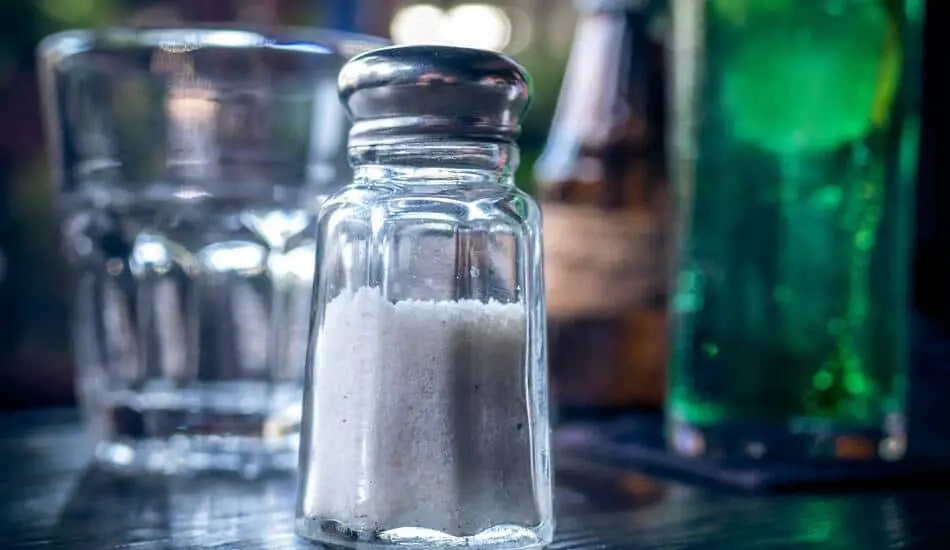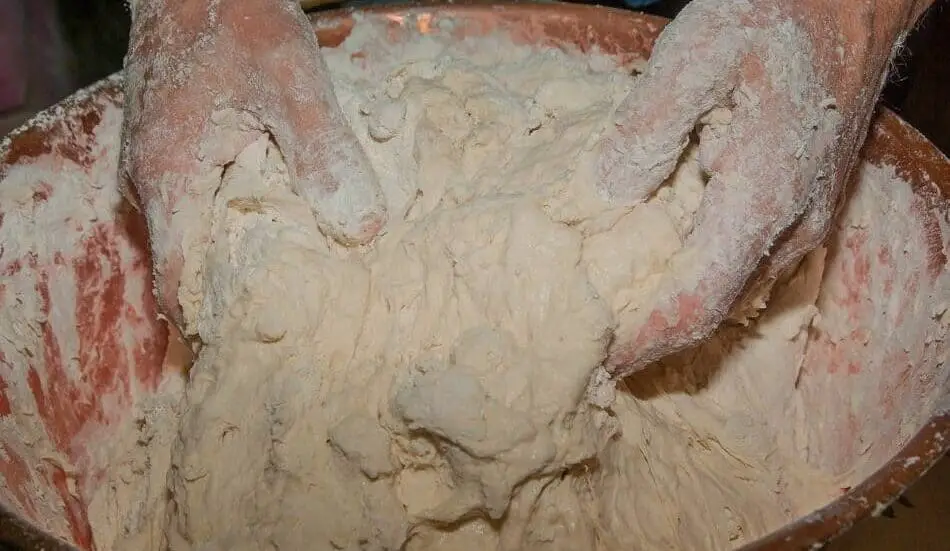Sourdough that has hydration levels of more than 72% tends to be sticky and tears apart easily when it is handled. We can prevent wet sourdough from sticking by oiling our work surfaces, using wet hands to handle the dough and dusting the proofing containers.
There are other reasons besides having very high hydration levels that can cause your sourdough to be wet and sticky. In this article we will look at all the factors that makes your sourdough excessively wet and sticky, as well as various ways we can reduce the wetness and stickiness of sourdough without changing its hydration level.
Dusting with flour is useful for some parts of the baking process for preventing sourdough from sticking, but it is not the best method for every application; other methods for preventing sourdough from sticking is to wet your hands with water, oiling the work surfaces and using parchment paper for baking.
6 reasons why sourdough gets excessively wet and sticky
1. Working with dough that has very high hydration level
When working with high hydration level dough, the dough gets very close to the point of 100% saturation from the high quantity of water, and it is difficult to get any more water to be incorporated into the dough. This excess water is not retained inside the dough but rather coats the dough’s surface causing it to be wet and sticky.
However, sourdough hydration levels can be pushed past 100% with the right technique which we will discuss in the subheading below.
It is completely normal for very high hydration doughs at more than 75% hydration to feel excessively slack, wet and sticky after the mixing phase. The dough will develop further in strength becoming dry and workable, as it will be able to retain more moisture once it has gone through the bulk fermentation phase and the folding phase.
2. Insufficient gluten network from under mixing
Dough is sticky and wet from under mixing as insufficient gluten network is developed to hold in the water molecules. Gluten is impermeable, meaning it doesn’t allow gas or water to pass through, when there isn’t enough gluten in the dough, water molecules can easily escape out of the dough, resulting in dough mixture that is only partly incorporated with water.
The remaining water coats the outside of the dough, causing it to appear wet and sticky.

3. Gluten network that breaks down from over mixing
The gluten network serves to provide structure and strength to the dough but it also plays an important role in containing and holding water and moisture. When the dough is excessively over mixed, it first becomes very strong and stiff, then when mixed further, the gluten network starts to unravel and unknits, releasing the absorbed water out into the dough environment, causing it to be wet and sticky.
4. Using flour with a high percentage of damaged starch particles
All flour has a certain percentage of damaged starch particles, but when the amount of damaged starch particles exceed 10%, dough becomes wet and sticky.
Flour contains starches, and some of these starch molecules inevitably cracks and breaks due to the harsh milling process; these are known as damaged starch particles. The problem with damaged starches comes from the over absorption of water.
Damaged starch absorbs water during mixing as opposed to undamaged starch where the water merely coats the outer surface. The water absorbed from the damaged starches is then gradually released and the dough that was initially dry and strong becomes wet, sticky and weak over time.
5. Baking with soft water
The hardness of water measures how much calcium and magnesium ion is present (expressed as ppm). Soft water has <50ppm, medium 50-100ppm (best for bread baking), hard >200ppm.
When water is excessively hard, it tightens the gluten as well as decrease fermentation rate. When water is excessively soft, the lack of minerals results in a sticky and slack dough.

6. The lack of salt
Salt is called for in every bread formulation, but it is the one ingredient that we most commonly tend to forget to include into our mix. Without salt, the dough becomes sticky and slack in nature, making it difficult to work with.
How to make sourdough less wet and sticky without changing the hydration level?
1. Proper mixing time to avoid under mixing and over mixing
Under mixing and over mixing results in insufficient gluten strands to trap water inside the dough, causing the dough to be wet and sticky.
We want to mix the dough until it develops adequate gluten network which is indicated by a dough that is stretchable without tearing but at the same time offers a degree of resistance when pulled apart.
Different types of mixers uses different mixing arm which develops the dough at different rates. The average total mixing time when using a spiral mixer is around 6 minutes of total mixing (includes first speed mixing time and second speed mixing time).
The table below is extracted from Jeffrey Hammelman’s Bread Book that shows the relative mixing time between different mixers and hand mixing to develop the same dough to the same strength.
We can use the mixing time below as a sanity check to determine if we have indeed under mixed or over mixed our dough; if you fall way out from the range in the table, increase or decrease mixing time to stay within these guidelines.
| Mixer | First Mixing (Minutes) | Second Mixing (Minutes) | Total Mixing Time (minutes) |
| Spiral | 3 | 3 | 6 |
| Planetary | 3 | 7 | 10 |
| Oblique | 5 | 9 | 14 |
| Stand Mixer (KitchenAid Type All Purpose Mixer) | 2.5 | 4.5 | 7 |
| Hand Mixing | 2 | 7 | 9 |
2. Using the bassinage method for mixing very wet doughs
When mixing dough of very high hydration, it can often be excessively wet and sticky and you may find it difficult for the dough to hold in all that water. This happens because it is more difficult for gluten network to be developed in a wetter dough, which makes it more difficult for water to be retained into the dough, and the dough tends to stay wet and sticky throughout mixing.
The bassinage technique is used to help build the dough up to the desired high level of hydration in stages.
When mixing, hold back a portion of the intended total water quantity called for in the formulation. Mix the drier dough until it has developed into the desired dough strength. Then, introduce the remaining water in stages and mix only until the water is incorporated into the dough.
As gluten develops more readily in a drier environment, this method allows the extra hydration to be easily incorporated into the dough.

3. Autolyse your dough
Autolyse is an important part of the baking process where flour and water is initially mixed without any other ingredients and left to rest for about 20 to 60 minutes. During this time, the flour has the chance to fully hydrate and gluten network is able to develop in spite of the lack of mechanical mixing.
As the flour is better hydrated, more water is absorbed by the dough, and less water is coating the dough’s surface which makes the dough feels less wet and sticky. The dough that is autolysed also contains more gluten strands which is able to trap more water inside the dough.
Autolyze reduces the wetness and stickiness of the dough and makes mixing and handling of the dough much easier.
4. Folding
It is normal when working with dough of very high hydration for it to feel quite wet and sticky after it has finished mixing. Once mixed, the dough enters the bulk fermentaiton phase where folding also takes place which helps significantly to develop more gluten network as well as to incorporate more water into the dough making it feel less wet and sticky.
One fold consists of the folding of all four sides of the dough into its centre. We should fold once every hour of bulk fermentation. After every fold, you will notice a significant improvement in dough strength and significant reduction in the wetness and stickiness of the dough.
5. Use European flour instead of American flour
When the percentage of damaged starch particles in flour exceeds 10%, your dough will become wetter and stickier over time.
If you find your dough to be relatively dry after mixing, but gets wetter and stickier over time, it means that the flour you are using contains a very high percentage of damaged starch particles; try changing to a different flour brand and use European flour instead of American flour.
American flour has a damaged starch percentage of roughly 8-9% while European flour has a lower damaged starch percentage at about 7%. Damaged starch particles also varies from one milling facility to another.
6. Use water of medium hardness at 50 – 100 ppm
Water that is too soft causes dough to be sticky and slack from the lack of minerals; reverse osmosis water and soft tap water can cause your dough to be too wet and sticky.
Use mineral water of a known hardness or test your tap water to be sure that your water has the appropriate hardness level for bread baking.
7. Taste for salt before mixing
When using the autolyse method which call for the initial incorporation of only flour and water without salt, we may sometimes forget to include salt in the final mixing phase. Always taste the mix to be sure that salt has been added before mixing.
How to prevent sourdough from sticking on your hands and baking surfaces?
We should aim to minimize the use of dusting flour in the baking process as the introduction of additional flour into our mix can significantly change the hydration level of the dough, resulting in a crumb that is drier and denser.
Another reason we want to minimize dusting is because the additional flour from dusting is not well hydrated and when baked can leave unsightly gray streaks on your sourdough bread that taste raw.
1. Oiling your work surface instead of dusting with flour
Oiling works just as well as dusting to create a non-stick surface which prevents your sticky dough from sticking and tearing. Oil the mixing bowl, the bowl used for bulk fermentation and folding, and the proofing vessel.
Only oil the proofing vessel if it is made of a non-porous material such as metal or glass, if it is made of a porous material like wood, then line the proofing vessel with a cloth and dust the cloth with flour.

2. Wet your hands instead of dusting with flour whenever you are handling the dough
Wet and sticky dough not only sticks to the work surfaces but also to our hands, increasing the risk of tearing and making it very difficult to work with.
The recommended method to prevent wet and sticky dough from sticking to our hands is to wet our hands with water whenever we are handling the dough; wet dough sticks to dry hands, but wet dough does not stick to wet hands. This is the preferred method used by professional artisan bakers.
3. Wet your hands and dust work surface lightly when shaping
During shaping, we want to wet our hands to prevent the dough from sticking to it. At the same time, we should dust the work surface lightly during shaping as we need some level of stickiness and friction between the dough and the work surface to create sufficient skin tension.
Skin tension during shaping is developed when one side of the dough sticks lightly on the work surface while the hands pulls the dough inwards from the opposite side, stretching the surface of the dough taut.
If you wet or oil the work surface, the dough will just glide over the work surface and not able to be pulled taut during shaping. Too much dusting of flour can also reduce stickiness to the point where sufficient skin tension is not able to be developed.
4. Dust your proofing basket with flour
The proofing basket is typically made with wood and it is quite porous. Oiling our proofing basket will cause the oil to be absorbed and be ineffective in preventing the dough from sticking. When using a proofing basket, line it with a clean cloth and dust its surface with flour by using a sieve to ensure an even coating.
If you are proofing your dough in a non porous material such as a metal or glass container, then oiling is preferred over dusting with flour.
The usual choice of flour for dusting includes bread flour, rice flour, semolina; all these flour works just as well for preventing sourdough from sticking. Semolina (used for dusting pizza dough) however is much coarser in texture and it really comes down to your personal preference; if you like the coarse texture by all means go for it.
Avoid using cake or pastry flour for dusting as it contains a higher starch content and tends to lump up more than bread, rice or semolina flour.
5. Use baking parchment paper when baking
Similarly, the reason we use baking parchment paper when baking is to minimize the use of additional flour in the baking process. Baking parchment paper is characteristic for its non stick ability without the need for any dusting of flour or oiling.


